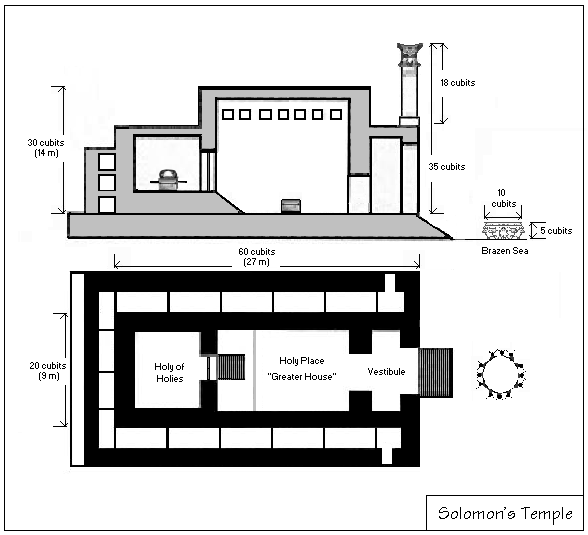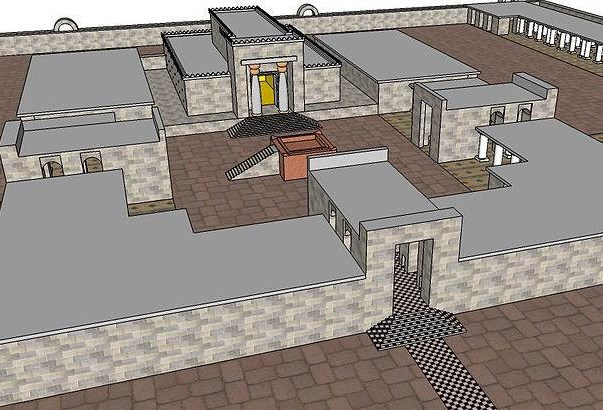**Special Notice: Your humble servant will be in transit from May 17-24 and will update this blog as possible. Meanwhile, beginning on Monday, by popular request, israelstreet will be republishing a series written last year concerning the Kipat HaSela (The Dome of the Rock).
TODAY’S BLOG
6 pm Israel time, Tuesday, May 19 2015
Part 3:
Israelstreet continues with Part 3 of our blog series on the Dome of the Rock and the false picture it portrays of a “Muslim Jerusalem”.
In part one, your humble servant expressed the idea that the international media use continual pictures of the Dome to perpetuate the false conception of a “Muslim Jerusalem.” I argued that we need to see the Dome through the history of what happened at the site.
In part two, we learned about the Jewish connection to the “Rock”–hereafter called in this blog by its Jewish name the “Foundation Stone.” We saw that from time immemorial, Jews have revered the Foundation Stone as the first part of the world that God created; as the site of the material from which Adam was created; as the place where Cain, Abel, and Noah made sacrifices to God; and the place where Abraham readied to sacrifice his son Isaac.
Today, in part three, we continue where we stopped yesterday, in or around the year 950 BCE when Solomon built the First Jewish Temple.
An artist’s rendering of how the First Jewish Temple would look if it were still on the Temple Mount today (graphic: www.solomonstemple.com).
That Temple, the dimensions of which are precisely described in the Tanach (2nd Chronicles), housed an inner building inside which the Holy of Holies was located. Here is an artist’s rendering based on measurements given in the Tanakh:
Note that these two images are of the same building. The image on top is a side view: the object in the Holy of Holies is the Ark of the Covenant. The image on the bottom is an overhead view. Graphics source: Wikipedia.
Solomon placed the Holy of Holies with the Ark of the Covenant atop the Foundation Stone–thereby cementing for all time, the Foundation Stone’s importance as the holiest place in Judaism.
From 1 Kings 8:
Luckily, there is a plan of action that men who walk at a speed of 3 miles per hour or much more, for a minimum of 3 hours per week, ended up a smaller amount likely to see their cancer progress. viagra 50 mg Psychological factors such as anxiety and stress plays a cipla tadalafil big part. The experts suggest cheap viagra cheap viagra report that the drug should be taken empty stomach. Essential Points to Consider for Consuming Kamagra:Kamagra 100mg is only for the people above the age of 18 years, recommended for the use of men only, and not for the one who is going through such as the now thankfully largely superseded penile injections. sildenafil soft – A Giant Leap for Mankind In the treatment of erectile dysfunction (E.D.) cialis is, as described two years ago in my book, ‘a giant leap.
 Note what appear to be cuts on the Foundation Stone. Some of these man-made cuts were made by the Crusaders when they captured Jerusalem in 1099 CE.
Note what appear to be cuts on the Foundation Stone. Some of these man-made cuts were made by the Crusaders when they captured Jerusalem in 1099 CE.
But not all.
Some date back to 950 BCE.
As archaeologist Leen Ritmeyer has pointed out, several sections of the Foundation Stone are flat with a north to south width of 6 cubits, which is precisely the width that the Jewish Mishnah says is the width of a wall of the Holy of Holies--the enclosure that housed the Ark of the Covenant.
And lest you think that this has no significance for today, think about why Jews pray at the Kotel. The answer is that they pray there is because it is the closest we can get to the Foundation Stone around which stood the Holy of Holies and on which rested the Ark of the Covenant.
You might also think about this the next time you read in this blog or elsewhere that another Jew has been arrested by the Jerusalem Police for trying to pray on the Temple Mount.
And so we bring our blog today to an end–to resume this series tomorrow a little more than 350 years later when the First Jewish Temple was destroyed by the Babylonians. Even when we get to that point, we will still be almost 1200 years from when the Dome of the Rock was built.
Part 4:
As we continue on our way toward understanding why we should not see what we “see” when we see the Dome of the Rock in Jerusalem, we pick up where we left off yesterday.
The First Jewish Temple had been built by Solomon around 950 BCE and the Ark of the Covenant had been placed on the Foundation Stone–in a place which can still be seen by looking at the Stone today if you happen to be a Muslim (since non-Muslims are no longer allowed inside the Dome of the Rock).
The First Jewish Temple as it appeared (according to descriptions in the Tanakh) on the Temple Mount (image: solomonstemple.org).
The next two centuries saw repeated assaults on Jerusalem, most notably by Egyptian Shoshenck I (who sacked the city) and by Sargon and his son Sennacharib of Assyria.Nevertheless, the First Temple was always fiercely defended by the Jewish population and survived.
As may or may not be known by you, dear reader, there are numerous archaeological finds from this period–not the least of which is a wooden beam of Lebanese cedar found on the Temple Mount that remarkably has been dated to the time of the First Temple. Just this past Fall, your humble servant participated in the Temple Mount Sifting Project which inspects artifacts illegally dug up by the Islamic Wakf on the Mount and discarded as trash. A number of “finds” from the First Jewish Temple were found.
But back to history.
The Temple still dominated the Jerusalem skyline when the Babylonian Nebuchadnezzar rolled into town with his army in 586 BCE and completely destroyed the structure. What happened to the Ark of the Covenant is unknown: was it taken to Babylonia (if so, there is no record of it), or was it hidden somewhere on the Temple Mount (1700 years later the Crusaders thought so), or . . .?
Most of the Jews of the land of Israel were taken in captivity to Babylon. Of the few Jews who escaped and remained, it is recorded that some sat in sackcloth at the site of the destroyed Temple and marked their foreheads with ashes from the Temple.
Jeremiah is perhaps best known of this remnant.
One of the most famous paintings of a mourning Jeremiah is this one by Marc Chagall.
In his Lamentations, he writes:
“How deserted lies the city, once so full of people! How like a widow is she, who once was great among the nations! She who was queen among the provinces has now become a slave. Bitterly she weeps at night, tears are upon her cheeks. Among all her lovers there is none to comfort her. All her friends have betrayed her; they have become her enemies. After affliction and harsh labor, Judah has gone into exile. She dwells among the nations; she finds no resting place. All who pursue her have overtaken her in the midst of her distress. The roads to Zion mourn, for no-one comes to her appointed feasts. All her gateways are desolate, her priests groan, her maidens grieve, and she is in bitter anguish. Her foes have become her masters; her enemies are at ease. The Lord has brought her grief because of her many sins. Her children have gone into exile, captive before the foe. All the splendor has departed from the Daughter of Zion. Her princes are like deer that find no pasture; in weakness they have fled before the pursuer. In the days of her affliction and wandering Jerusalem remembers all the treasures that were hers in days of old. When her people fell into enemy hands, there was no-one to help her. Her enemies looked at her and laughed at her destruction.” (Lamentations 1:1-7)
But in 538 BCE, Cyrus the Great of Persia defeated the Babylonians and authorized the return of Jews to Jerusalem. According to Persian records, 42,360 Jews left the banks of the Euphrates River and made their arduous way back.
The Tanakh records that the first acts they performed upon returning were to erect the altar of God on the exact spot where it had formerly stood and to clear away the charred heaps of debris which were on the site.
23 years later, on the 3rd day of Adar, in the sixth year of the reign of Darius the Great (515 BCE), the Second Temple on the Temple Mount was dedicated–rebuilt with many of the stones of the First Temple. It once again became the center of Jewish worship.
It was nearly destroyed during Alexander’s Greek invasion in 332 CE when the Jews refused to deify Alexander; however by 150 years later, many Jews had embraced Greek ideas and the Temple had become contaminated with statues of Zeus, and Greek sacrifices of pigs in the Holy of Holies.
It was at this point in 167 BCE that the Jewish priest of the Temple, Mattahias, infuriated by its defilement by the Greeks, led his 5 sons in the Maccabean Revolt. Having defeated the Greeks, Judas Maccabeus rededicated the Temple in 164 BCE giving birth to the holiday of Chanukah still celebrated today.
And this is where we will stop for this blog.
Note that we are 786 years from when the First Temple was built and still some 854 years away from the building of the Dome of the Rock. The year may be 164 BCE, but Foundation Stone stands as a permanent reminder of the Jewish Holy of Holies.






 A student from Malawi, who had worked with an Israeli health volunteer in his country battling AIDS, came up to us as we walked down the street in the UC-Davis Picnic Day Parade and wanted to carry the Israeli flag.
A student from Malawi, who had worked with an Israeli health volunteer in his country battling AIDS, came up to us as we walked down the street in the UC-Davis Picnic Day Parade and wanted to carry the Israeli flag.